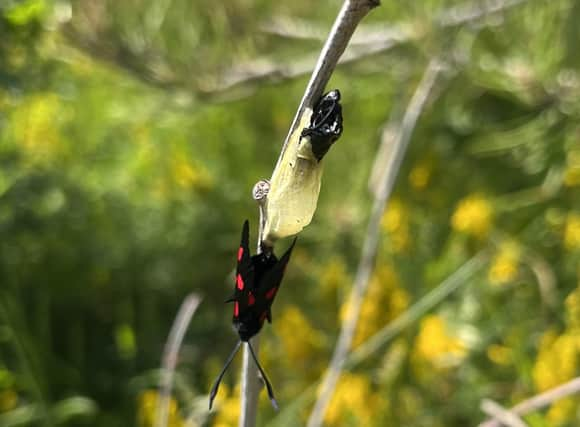Wildlife: Moths that don’t need to rush as predators soon avoid them


This five-spot burnet is one of our more striking day-flying moths. The caterpillars have green and black stripes and yellow spots down the body covered with tiny hairs protecting it from tiny parasitoid wasps which otherwise lay their eggs in their ‘living lunch’. As the larva pupates it transforms into the moth, and as that emerges from the white cocoon, the now empty pupal case is left behind. This is all clearly visible in Stephen’s photograph and the freshly emerging adult moth is in pristine condition. The five-spot burnet is the less frequent cousin of the more common six-spot burnet and tends to pupate rather closer to the ground. Brightly coloured moths and their caterpillars (such as cinnabar moths and their ‘tigers’ tails’ larvae) tend to be foul tasting in order to deter possible predators.
In this case, the burnet moths feed on leguminous plants such as bird’s-foot trefoil and vetches and are able to metabolise poisonous compounds (called glucosides) in the plant without themselves being harmed and thus generate hydrogen cyanide which is toxic and distasteful to larger animals that might feed on the moths. The striking red spots signal this potentially deadly or at least distasteful armoury. Instead of hiding away, the moths advertise their presence in order to be seen and noticed. In cinnabar moths, the larvae of which feed on toxic ragworts with nasty alkaloid chemicals (Jacobine, Jacodine, and Jaconine), absorb the poison to which they are immune and display themselves with bright orange and black markings (and hence the popular name ‘tigers’ tails). So, in this case both adults and larvae are toxic. Although these toxic moths flutter their wings quite fast, the overall flight is rather laboured and lazy. Afterall, they don’t need to rush as predators soon learn to avoid them. For these insects, both caterpillars and adults are poisonous, and they emerge synchronously to take advantage of they favoured flowers such as knapweed and scabious.
Contact Prof Rotherham on email: [email protected]; follow his blog https://ianswalkonthewildside.wordpress.com